|
Related FAQs: Hawaiian
Surgeonfishes, Surgeons In General, Tang
ID, Selection,
Compatibility,
Systems, Feeding, Disease,
Related Articles: Surgeonfishes, Acanthurus, Ctenochaetus, Naso,
Zebrasoma,
Indonesian Surgeons, Tangs and Doctorfishes
|
|
| Bob Fenner |
|
Surgeonfishes: Tangs for Marine Aquariums
Diversity, Selection & Care
New eBook on Amazon: Available here
New Print Book on Create Space: Available
here
by Robert (Bob) Fenner |
 |
Genus Acanthurus:
| Acanthurus
bariene Lesson 1831, the Black-Spot Surgeonfish. Indo-West
Pacific; Mozambique, Maldives to Indonesia. To 50 cm. Males develop
"nuchal humps" like cichlids. Feed on algae films on bare
rocks. Here in Mabul, Malaysia. |
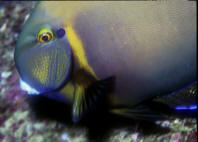
|
| Acanthurus chronixis
Randall 1960, a/the Mimic or Chronixis Surgeonfish. Very similar to
C. vrolikii, anterior two-thirds silver-gray to deep black
posteriorly, and identical blue highlights on the unpaired
fins. One in Sulawesi, the Angel in captivity. Pix by
RMF. |
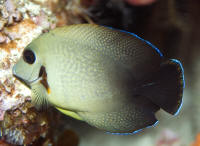
|
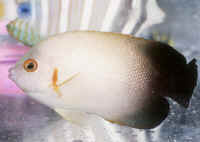
|
|
Acanthurus dussumieri Valenciennes 1835, the
Eyestripe or Dussumier's Surgeonfish. This is a highly
variably colored fish. Some are drab gray, whereas some I've
seen from Hawai'i sported brilliant yellow around their body
margin with beautiful royal purple highlights. This surgeon is
more like the genus Ctenochaetus in its feeding habits, sifting
sand and detritus in addition to algae scraping. Specimens off
Maui, in an a hobbyist tank and a profile of one off Queensland,
Australia. To eighteen inches long in the wild.
|
| Acanthurus japonicus (Fowler 1946), the
White-Faced Surgeonfish; also sold as a/the Gold-Rimmed or
Powder-Brown Surgeon, confusing it with A. glaucopareius
(nigricans) (see below). A. japonicus has a much larger
white eye patch. Ranges from the Philippines to Japan and is
relatively hardy. A nigricans, the Powder-Brown at right for
comparison (Nuka Hiva, Marquesas pic). |
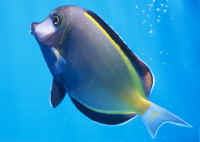
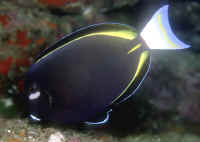
|
|
Acanthurus leucosternon Bennett 1832, the
Powder Blue Tang. I can hear some of you screaming, "this
isn't a difficult fish!" "I've known people to
keep the Powder Blue for years!" Most specimens don't
make it even through capture and shipping. Those that are well
received and cared for sometimes do live for a good long time.
Two maxims for success: One to a tank, and lots of live rock with
algae.
|
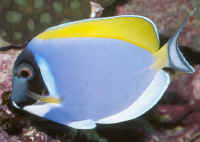
|
| Acanthurus lineatus (Linnaeus 1758), the
Striped, Pajama/Pyjama, Clown Surgeonfish. Indo-Pacific; with
exception of Red Sea (replaced by similar Sohal). An aggressive
species that causes trouble often with growth in aquariums. To
fifteen inches in length. Lives along reef edges of high water
movement, and oxygen concentration. At right: in Nuka Hiva,
Marquesas, Polynesia. Below: Specimens from the Seychelles,
Maldives and Australia. |
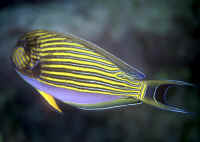
|
| Acanthurus mata Cuvier 1829, the Elongate or
Mata Surgeonfish. Indo-Pacific; Red Sea, eastern African coast to
French Polynesia, Japan, GBR, Micronesians. Similar to A. xanthopterus lives almost exclusively on
zooplankton. Long misidentified as A. bleekeri. To 50
cm. This one off of Gili Air, Lombok, Indonesia. |
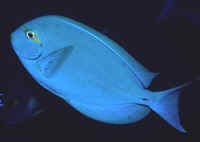
|
| Acanthurus
nigricans (Linnaeus 1758) Whitecheek to science, Powder
Brown Surgeonfish to aquarists. Formerly mis-identified as A.
glaucopareius. Pan Pacific. To about eight inches maximum length.
See article on this and the very similar, but more
pet-fish-appropriate A. japonicus. At right in
Nuka Hiva, Marquesas, Polynesia. Specimens below from
Australia, the Cooks (Roratonga) and Baja, Mexico. |
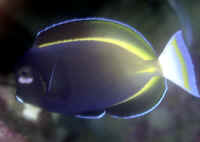
|
|
Acanthurus nigricauda Duncker & Mohr
1929, the Brown-Eared Surgeonfish (note the stripe behind the
eye); the most carnivorous Surgeon. Found in close association
with barracudas, even sharks in the Red Sea. Feeds on meat scraps
and small demersal animals. Grows to a length of twenty inches.
One off of Gili Air, Lombok, Indonesia, another in N. Sulawesi,
and last in the Maldives.
|
|
Acanthurus nigrofuscus (Forsskal 1775), the
blackish Brown or Spot-Cheeked Surgeonfish. Manageable size (to
eight inches), and moderate behavior toward other fishes qualify
the Brown Tang as a desirable aquarium species especially as an
algae controller. Unfortunately it is a rather plain fish. Red
Sea images of individual and group feeding together to overwhelm
more aggressive, territorial fishes.
|
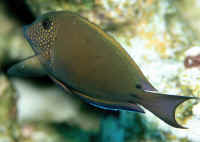 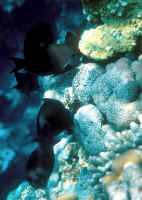
|
| Acanthurus olivaceus Forster &
Schneider 1801, the Orange Spot/Shoulder Tang. A hardy fish out of
Hawaii and elsewhere, but unfortunately, a behavioral terror in the
ranks of A. lineatus. This is an active fish that grows to
more than a foot in length. Place only with MEAN tankmates. A
juvenile, sub-adult and adult pictured, Fiji, Hawai'i and
Hawai'i respectively. |
| Acanthurus pyroferus see
below under: Mimic Tangs. Aquarium and Australian and N. Sulawesi
images of "wild type" individuals as adults. There are
quite a few mimic and mixed looking variants in this species. See
below under "Mimic Tangs". |
|
Acanthurus thompsoni (Fowler 1923), the
White-Tailed Surgeonfish, a good name for this species except for
its populations in Hawaii which bear no white on their tail
areas. Another name for this planktivore is Thompson's
Surgeonfish. Though not a striking beauty, this Whitetail tang is
a good feeder and stays moderate small (to ten inches). Rarely
imported into the trade. A Hawaiian specimen, one from the Cooks
and Australia's northern coast pictured.
|
|
Acanthurus triostegus (Linnaeus 1758),
(manini) Convict Tang or Manini (Hawaiian). One of the best
Acanthurus for use in reef tanks for its size, easy going
temperament and habit of consuming fine, filamentous algae.
Reserved for native Hawaiian use in Hawai'i, but available
from elsewhere. Juvenile in Hawai'i and a marauding school on
the prowl in the Cooks.
|
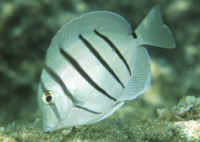 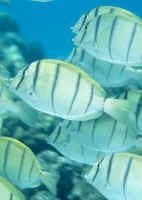
|
| Acanthurus xanthopterus Valenciennes 1835,
(pualu) the Yellowfin Surgeonfish. Similar to the Ringtail and
Eyestripe Surgeonfishes, but lacks the other two's light caudal
coloration. This is the largest member of the genus Acanthurus, to
about 22 inches long. A specimen in the Cooks. |
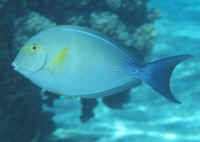
|
Genus Ctenochaetus
|
Ctenochaetus binotatus Randall 1955, the
Blue-Eye or Two-Spot Bristletooth for the two dark areas at the
rear of the dorsal and anal fin bases. Sometimes brought in from
the Philippines. Below: A juvenile in Mabul, Malaysia and adult
pix in Gili Air, Lombok, Indonesia and Fiji.
|
| Ctenochaetus striatus
(Quoy & Gaimard 1828) the Striped Bristletooth, is the one
member of the genus found extending into the Red Sea (but also
found in the Indo-Pacific to Oceania and the I.O.); it is the most
frequently imported species in Europe. It's body color is
overall drab olive sporting wavy blue lines. Small orange dots are
sprinkled on the head. Here are specimens in Fiji and the Red Sea
and a couple tussling in the Red Sea. |
|
Ctenochaetus tominiensis Randall 1955, the
Tomini Bristletooth (3), is occasionally brought in from the
Philippines. Of the four regularly available species of
Ctenochaetus, the Tomini Bristletooth, is the most difficult to
keep. Only Ctenochaetus with angular dorsal and anal fin ends.
Rarely imported. Aquarium and N. Sulawesi pix.
|
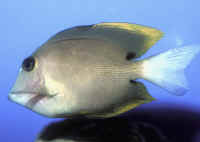 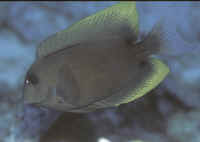
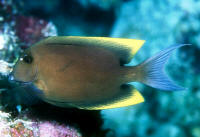
|
Genus Naso
| Naso annulatus (Quoy & Gaimard 1825),
the Whitemargin Unicornfish. Indo-Pacific; East Africa to
Hawai'i. To a meter in length. This eight inch one off of Heron
Island, Australia's Great Barrier Reef. |
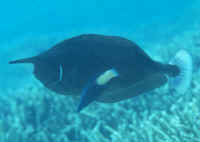
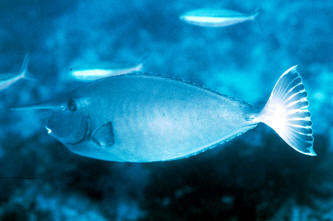
|
| Naso brachycentron (Valenciennes 1835), the
Humpback Unicornfish. Indo-Pacific; eastern Africa to the Marquesan
and Society Islands. To thirty six inches in length... yes a yard
long. Off of Gili Air, Lombok, Indonesia and N.
Sulawesi. |
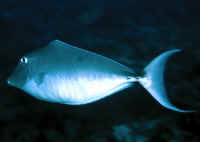
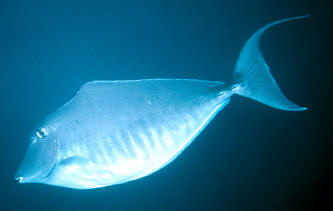
|
|
Naso brevirostris (Valenciennes 1835),
sometimes called the Shortnose Unicorn Tang, is mis-named both
scientifically and colloquially; it has a long nose as an adult.
There are Naso species with much shorter, even absent the
"horn" on the head. This grayish-green bodied fish is
occasionally imported from Hawaii and the Indo-Pacific. To two
feet long. Hawai'i and Fiji pix.
|
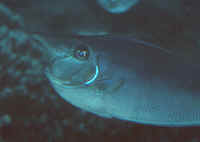
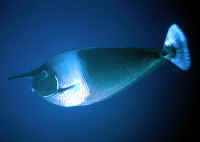
|
| Naso hexacanthus (Bleeker 1855), Sleek
Unicornfish. Indo-Pacific species... to about 30 inches in length.
Not kept in home aquariums... as are other too-large Naso species
from these islands. Neither males nor females develop a horn; but
do have black tongues! One in Hawaii, a flashing male in the Red
Sea and a more "normal" colored one getting a clean-up
job there by Labroides shown below. This species has a dark margin
on its preopercle and operculum that helps distinguish it from
similar species. |
|
Naso lituratus,
the Naso Tang to most aquarists; it is
also known as the tricolor or lipstick tang. There are some who
claim that "blonde" and "streamer" versions
are different species; they're all Naso lituratus. To
eighteen inches in the wild. Below, a Naso in an aquarium,
he business end of a Naso in Hawai'i, and a beautiful
"streamer" (male) there getting cleaned by a Cleaner
Wrasse.
|
|
Naso vlamingi (Valenciennes 1835),
Vlaming's Unicornfish has naught but a convex nose bump for a
horn. Adult males are especially beautiful with bright blue and
white highlights over a dark blue body. Juvenile in Moorea,
French Polynesia and Female in Pulau Redang, Malaysia shown.
|
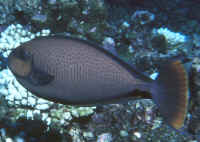 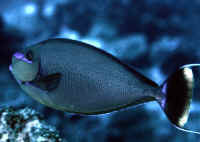
|
Genus Paracanthurus
| Paracanthurus hepatus (Linnaeus 1766), the
(Pacific) Yellow-Tailed Blue, Palette, Regal, or Hepatus Tang.
Indo-Pacific; East Africa to the Line Islands. Found in loose
aggregations near Pocillopora corals in which they dive into to
hide. To a foot long in the wild, rarely more than half that in
captivity. A zooplankton feeder principally, feeding on microalgae
secondarily. |

|
Genus Zebrasoma
|
Zebrasoma scopas (Cuvier 1829), the Brown
or better, Two-Tone Sailfin Tang. The former common name can be a
bit of a misnomer; I have seen scopas specimens as
brightly yellow as a flavescens and as dark as a
rostratum. As young they're different still, with
light colored fronts grading to dark variable spots and lines.
Occasional "dirty" or mixed-color crosses between the
brown and Z. flavescens are encountered along their
contiguous distributions. Widely ranging in the Indo-Pacific.
Shown: Two juveniles in the (tiny one inch one in Australia,
larger in the Maldives), and a mid-adult in captivity to show
color range.
|
| Zebrasoma veliferum (Bloch 1795), the
Pacific Sailfin Tang. Collected out of the Philippines and
Indonesia, though better out of Hawaii, Ceylon and other places in
the eastern Pacific. Some call this THE Sailfin tang for it's
gorgeous flowing dorsal and anal finnage; these especially
over-sized in appearance when young. Here are two and four inch
juveniles in Fiji and a larger (10") individual in
Hawai'i. As mentioned above D. desjardinii is considered
a junior synonym of this species currently. |
Surgeonfishes: Tangs for Marine Aquariums
Diversity, Selection & Care
New eBook on Amazon: Available here
New Print Book on Create Space: Available
here
by Robert (Bob) Fenner |
 |
|
|

